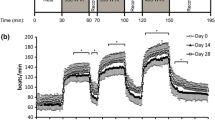Summary
A study was carried out on three groups of 20 male subjects to determine the combination of environmental stress and a standard rate of work of 5 kcal/min that will give the “optimum” level of acclimatisation.
Each group was acclimatised at one of three temperature conditions (wet-bulb temperatures of 32.2 °, 33.9 ° and 35.6 ° C) and thereafter tested also under the remaining two conditions.
The degree of acclimatisation was judged by the physiological reactions to a standard work rate of 5 kcal/min at the various wet-bulb temperatures. The test at a wet-bulb temperature of 32.2 “C revealed that °optimum” acclimatisation was obtained when men were acclimatised at 33.9 °C W.B. The test at 33.9 °C W.B. illustrated that the physiological reactions of the group acclimatised at 35.6 ° C W.B. were decidedly poor when compared to those of the groups acclimatised at 32.2 ° and 33.9 ° C W.B. The test carried out at 35.6 ° C W.B. showed that, irrespective of the wet-bulb temperature at which the men were acclimatised, their heat tolerance to the test environment was poor.
Similar content being viewed by others
References
Eichna, L. W., W. F. Ashe, W. B. Bean, andW. B. Shelley: The upper limits of environmental heat and humidity tolerated by acclimatised men working in hot environments. J. industr. Hyg.27, 59–84 (1945).
,W. B. Bean, W. P. Ashe, andN. Nelson: Performance in relation to environmental temperature. Bull. Johns Hopk. Hosp.76, 25–58 (1945).
,C. R. Park, N. Nelson, S. M. Horvath, andE. D. Palmes: Thermal regulation during acclimatisation in a hot, dry (desert type) environment. Amer. J. Physiol.163, 585–597 (1950).
Ellis, F. P., H. M. Ferres, A. R. Lind, andP. S. B. Newling: The upper tolerable levels of warmth for acclimatised European men working in the tropics. Memor. med. Res. Coun. (Lond.), R.N.P. Rep.53, 759 (1953).
Iampietro, P. F., andR. F. Goldman: Tolerance of men working in hot, humid environments. J. appl. Physiol.20, 73–76 (1965).
Robinson, S., E. S. Turrell, andS. D. Gerking: Physiological equivalent conditions of air temperature and humidity. Amer. J. Physiol.143, 21–32 (1945).
Wyndham, C. H.: Effect of acclimatisation on the sweat rate/rectal temperature relationship. J. appl. Physiol.22 27–30 (1967).
,W. v. d. M. Bouwer, H. E. Paterson, andM. G. Devine: Practical aspects of recent physiological studies in Witwatersrand gold mines. J. Chem. Metal. and Mining Soc. of S.A.7, 287–313 (1953).
Author information
Authors and Affiliations
Rights and permissions
About this article
Cite this article
Williams, C.G., Wyndham, C.H. & Heyns, A. The problem of “optimum” acclimatisation. Int. Z. Angew. Physiol. Einschl. Arbeitsphysiol. 26, 298–308 (1968). https://doi.org/10.1007/BF00698306
Received:
Issue Date:
DOI: https://doi.org/10.1007/BF00698306



